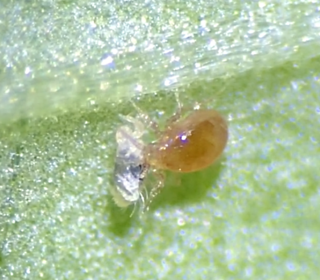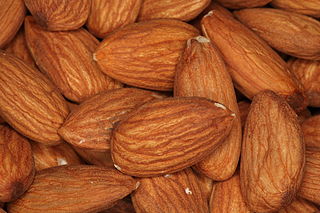
Biological control or biocontrol is a method of controlling pests, whether pest animals such as insects and mites, weeds, or pathogens affecting animals or plants by using other organisms. It relies on predation, parasitism, herbivory, or other natural mechanisms, but typically also involves an active human management role. It can be an important component of integrated pest management (IPM) programs.

A lima bean, also commonly known as the butter bean, sieva bean, double bean or Madagascar bean is a legume grown for its edible seeds or beans.

A metapopulation consists of a group of spatially separated populations of the same species which interact at some level. The term metapopulation was coined by Richard Levins in 1969 to describe a model of population dynamics of insect pests in agricultural fields, but the idea has been most broadly applied to species in naturally or artificially fragmented habitats. In Levins' own words, it consists of "a population of populations".

Leptoconops torrens is a species of small biting flies in the no-see-um family Ceratopogonidae. They were first mentioned in writing by Charles Henry Tyler Townsend in 1893. The name Leptoconops carteri is a junior synonym of L. torrens. They are prevalent in the southwestern and southeastern areas of the United States. In early stages of life, L. torrens flies dwell in soil, then emerge to feed and breed as fully developed adults.
The Winkler Index, sometimes known as the Winkler Scale or WinklerRegions, is a technique for classifying the climate of wine growing regions based on heat summation or growing degree-days. In the system, geographical areas are divided into five climate regions based on temperature converted to growing degree-days, and is commonly known as Regions I–V. The system was developed at the University of California, Davis by A. J. Winkler and Maynard Amerine.

Icerya purchasi is a scale insect that feeds on more than 80 families of woody plants, most notably on Citrus and Pittosporum. Originally described in 1878 from specimens collected in New Zealand as pests of kangaroo acacia and named by W.M. Maskell "after the Rev. Dr. Purchas who, [he] believe[d], first found it". It is now found worldwide where citrus crops are grown. The cottony cushion scale originates from Australia.

The Phytoseiidae are a family of mites which feed on thrips and other mite species. They are often used as a biological control agent for managing mite pests. Because of their usefulness as biological control agents, interest in Phytoseiidae has steadily increased over the past century. Public awareness of the biological control potential of invertebrates has been growing, though mainly in the US and Europe. In 1950, there were 34 known species. Today, there are 2,731 documented species organized in 90 genera and three subfamilies.
Rodeo Creek is an 8.3-mile-long (13.4 km) intermittent stream in western Contra Costa County, California running through the town of Rodeo to San Pablo Bay.
Carl Barton Huffaker was an American biologist, ecologist and agricultural entomologist.

Celery mosaic virus (CeMV) is a plant pathogenic virus in the genus Potyvirus and the virus family Potyviridae .
In 1958, Carl B. Huffaker, an ecologist and agricultural entomologist at the University of California, Berkeley, did a series of experiments with predatory and herbivorous mite species to investigate predator–prey population dynamics. In these experiments, he created model universes with arrays of rubber balls and oranges on trays and then introduced the predator and prey mite species in various permutations. Specifically, Huffaker was seeking to understand how spatial heterogeneity and the varying dispersal ability of each species affected long-term population dynamics and survival. Contrary to previous experiments on this topic, he found that long-term coexistence was possible under select environmental conditions. He published his findings in the paper, "Experimental Studies on Predation: Dispersion Factors and Predator–Prey Oscillations".

Phoresis or phoresy is a non-permanent, commensalistic interaction in which one organism attaches itself to another solely for the purpose of travel. Phoresis has been observed directly in ticks and mites since the 18th century, and indirectly in fossils 320 million years old. It is not restricted to arthropods or animals; plants with seeds that disperse by attaching themselves to animals are also considered to be phoretic.
Self-perpetuation, the capability of something to cause itself to continue to exist, is one of the main characteristics of life. Organisms' capability of reproduction leads to self-perpetuation of the species, if not to the individual. Populations self-perpetuate and grow. Entire ecosystems show homeostasis, and thus perpetuate themselves. The slow modifying effect of succession and similar shifts in the composition of the system can, however, not be neglected in the long run. Overall, life's object's capabilities of self-perpetuation are always accompanied by evolution, a perfect steady state of the biological system is never reached. Sexual reproduction is also a form of imperfect self-replication and thus imperfect self-perpetuation because of recombination and mutation. Organisms are not like self-replicating machine but amass random modifications from generation to generation. The property of self-perpetuation in the strict sense thus only applies to life itself.

Agriculture is a significant sector in California's economy, producing nearly US$50 billion in revenue in 2018. There are more than 400 commodity crops grown across California, including a significant portion of all fruits, vegetables, and nuts in the United States. In 2017, there were 77,100 unique farms and ranches in the state, operating across 25.3 million acres of land. The average farm size was 328 acres (133 ha), significantly less than the average farm size in the U.S. of 444 acres (180 ha).
Albert Julius Winkler was an American professor of viticulture and one of its leading authorities. His name is famous for the Winkler index, developed with Maynard Amerine.
Vernon Mark Stern was an American professor of entomology at the University of California, Riverside considered as one of the founding figures of integrated pest management.
Stephen Wilhelm was a professor of plant pathology, known for his success in controlling Verticillium wilt. His research on plant hybridization and soil fumigation contributed to revolutionary developments in the strawberry and raspberry industries.
Curtis Paul Clausen was an American entomologist and professor at the University of California, Riverside, who specialized in biological control. He wrote an influential text on the biology of insect predators and parasites, Entomophagous Insects (1940).

Planococcus ficus, commonly known as the vine mealybug, is a species of mealybug, belonging to the family Pseudococcidae, native to tropical and subtropical regions. The vine mealybug is found in Europe, Northern Africa, Southern Africa, the Americas, and the Middle East. The vine mealybug is invasive to weedy plants in many different regions of the world.
Ferrisia is a genus of mealybugs.









